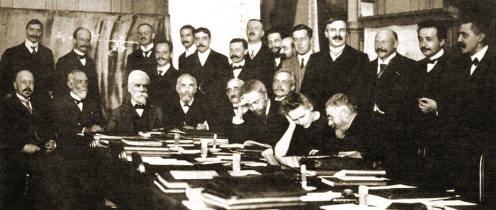|
home | what's new | other sites | contact | about |
||
|
Word Gems exploring self-realization, sacred personhood, and full humanity
Quantum Mechanics
return to "Quantum Mechanics" main-page
Gérard P. Michon: "Ernest Solvay (1838-1922) was a Belgian chemist and industrialist whose patents brought him considerable wealth, which he used to bankroll several philanthropic endeavors. In 1894 he founded a sociology institute at the University of Brussels, called "Institut des Sciences Sociales" (ISS). In 1903, he founded the Solvay Business School, also at the University of Brussels. Finally, in 1911, he established the prestigious meetings of top scientists known as Solvay Conferences. The first and the fifth of these (1911 and 1927) are particularly noteworthy, as they helped define the foundations for the first and second incarnations of quantum theory."
Left-to right: Standing: Robert Goldschmidt, Max Planck, Heinrich Rubens, Arnold Sommerfeld, from springer.com Late in October 1911, eighteen leading scientists from all over Europe met to the first of a famous sequence of Solvay conferences in Brussels. This historical meeting was mainly devoted to “The Theory of Radiation and the Quanta”, at a time when the foundations of physics were totally shaken. Although “nothing positive came out” (Einstein), it is interesting to see the diverging attitudes of Europe’s most famous scientists in the middle of the quantum revolution. After a few general remarks about the conference, I shall focus on some of the most interesting contributions and discussions. Einstein, at 32 ... was clearly most aware of the profound nature of the crises. He gave the final talk entitled “The Present State of the Problem of Specific Heats”, but he put his theme into the larger context of the quantum problem, and caused a barrage of challenges, in particular from Lorentz, Planck, Poincaré, and others. Wikipedia: Hendrik Lorentz was chairman of the first Solvay Conference on Physics, held in Brussels from 30 October to 3 November 1911. The subject was Radiation and the Quanta. This conference looked at the problems of having two approaches, namely classical physics and quantum theory. Albert Einstein was the second youngest physicist present (the youngest one was Lindemann). Other members of the Solvay Congress were experts including Marie Curie, Ernest Rutherford and Henri Poincaré (see image for attendee list).
|
||
|
|
